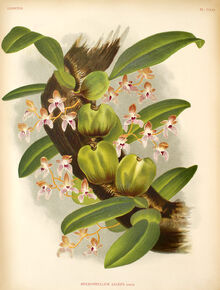| Bulbophyllum | ||||||||||||||||
|---|---|---|---|---|---|---|---|---|---|---|---|---|---|---|---|---|
|
| ||||||||||||||||
| ||||||||||||||||
Bulbophyllum is the largest genus in the orchid family Orchidaceae. With 1805 species, it is also one of the largest genera in the entire plant kingdom, exceeded only by Senecio and Euphorbia. This genus is abbreviated in the trade journals as Bulb.
Distribution[]
The center of diversity is in the montane forests of Papua New Guinea (more than 600 species) which seems to be the evolutionary homeland, though the genus is pantropical and widespread, occurring in Australia, Southeast Asia with over 200 species in Borneo), Africa Madagascar (with 135 species, some endemic) and in tropical Central and South America.
Description[]
This genus was first described by Louis-Marie Aubert du Petit-Thouars (botanical abbreviation Thouars) in his book "Histoire particulière des plantes orchidées recueillies sur les trois Iles Australes d’Afrique, de France, de Bourbon et de Madagascar", describing 17 Bulbophyllum species. There are now more than 2,800 records (accepted names and synonyms) for this genus. This large number and the great variety of its forms make this genus a real nightmare for a taxonomist: 120 sections and subgenera have been listed. Some of these may deserve a generic status and several species have ten synonyms.
The general characteristics for this genus are: single-noded pseudobulbs, the basal inflorescence and the mobile floral lip.
This genus covers a wide range of vegetative forms, from tall plants with cane-like stems, to root climbers that wind or creep their way up tree trunks. Other members are pendulous epiphytes (growing on other plants), and quite a number that have developed succulent foliage to a greater or lesser degree. Some species are lithophytic. One species is almost leafless and uses its pseudobulbs as the organs of photosynthesis.
These orchids with a sympodial growth have rhizomatous stems with often angled pseudobulbs. The thin to leathery leaves are folded lengthwise.
Many Bulbophyllum species have the typical odor of rotting carcasses, and the flies they attract assist in their reproduction through pollination.
The erect to pendent inflorescence arises laterally from the base of the pseudobulb. The flower form has a basic structural blueprint that serves to identify this genus. But this form can be very diverse: compound or single, with few to many flowers, with the resupinate flowers arranged spirally or in two vertical ranks. The sepals and the petals can also be very varied : straight or turned down, without footstalk or with a long claw at the base. They are often hairy of callous. There are two to four hard and waxy pollinia with stipes present or absent. The fruits are beakless capsules.
Conservation status[]
A number of Bulbophyllum species are threatened with extinction, and are recognised as such by the World Conservation Union (IUCN):
- Bulbophyllum bifarium, Vulnerable
- Bulbophyllum filiforme, Critically endangered
- Bulbophyllum gravidum, Vulnerable
- Bulbophyllum jaapii, Vulnerable
- Bulbophyllum kupense, Critically endangered
- Bulbophyllum modicum, Endangered
- Bulbophyllum nigericum, Vulnerable
- Bulbophyllum pandanetorum, Endangered
- Bulbophyllum rubrolabellum, Endangered
- Bulbophyllum tokioi, Endangered
Additionally, Bulbophyllum porphyrostachys is listed as near threatened.
Culture[]
Plants usually grow in in intermediate to warm temperatures. Keep moist in summer seasons and do not allow mix to dry, in winter keep the mix slight dry and reduce watering. Watering usually varies between plants Keep good air movement to avoid fungal growth. Keep plants in shade. Pot plants in sphagnum moss, fine bark, or mounted.
Naming[]
The scientific name has been derived from the Latin word bulbus (bulb-like) and the Greek word phyllon (leaf), referring to the pseudobulbs on top of which the leaf is growing.
Synonyms[]
- Anisopetalum Hkr. 1825.
- Bolbophyllaria Rchb.f 1852.
- Bolbophyllum Spreng. 1826.
- Cochlia Bl. 1825.
- Didactyle Lindley 1852.
- Diphyes Bl. 1825.
- Ephippium Blume 1825.
- Epicranthes Bl. 1825.
- Epicrianthes Bl. 1828.
- Gersinia Neraud. 1826.
- Henosis Hkr.f 1890.
- Katherinea A. D. Hawkes 1956.
- Lyraea Lindl. 1830.
- Macrolepis A. Rich. 1834.
- Malachadenia Lindley 1839.
- Megaclinium Lindley 1826.
- Odontostyles Breda 1827.
- Osyricera Bl. 1825.
- Oxysepala Wight 1851.
- Phyllorchis Thou. 1822.
- Sarcopodium Lindley & Paxton 1850.
- Sestochilos Breda 1828.
- Sunipia Lindley 1826.
- Taurostalix Rchb.f. 1852.
- Tribrachia Lindley 1824.
- Xiphizusa Rchb.f 1852.
- Zygoglossum Reinw. 1826 [1828].
Species[]
References[]
| This page uses Creative Commons Licensed content from Wikipedia (view authors). | 
|
